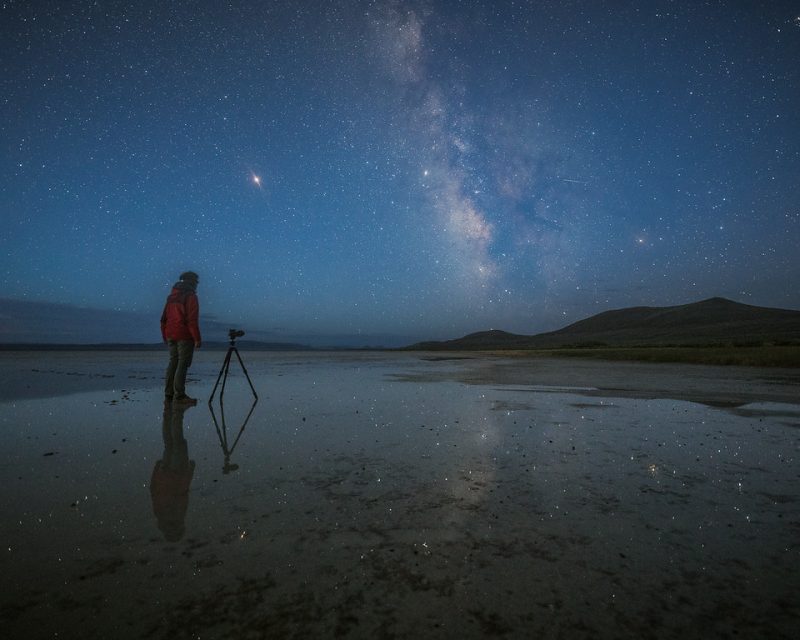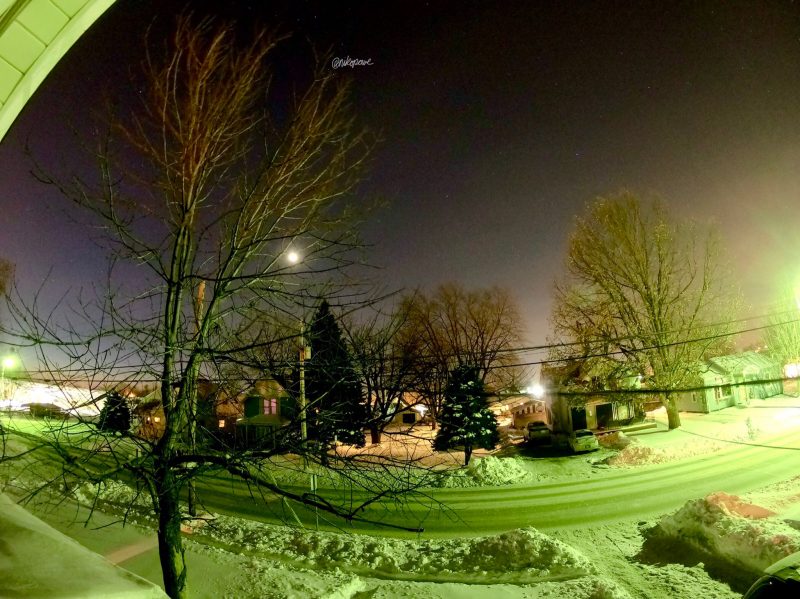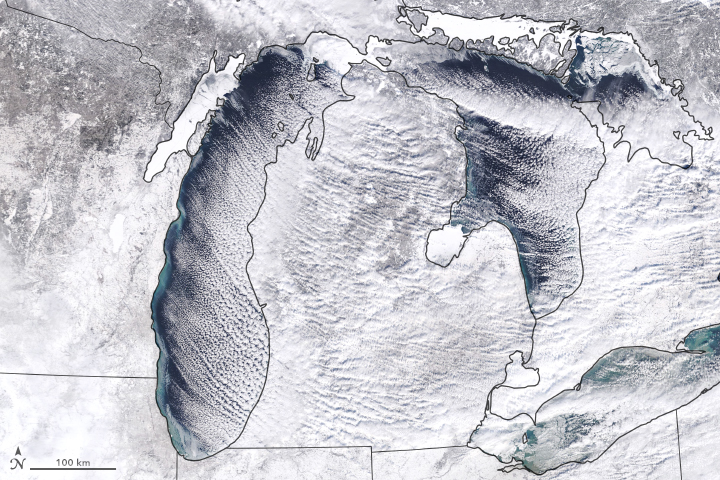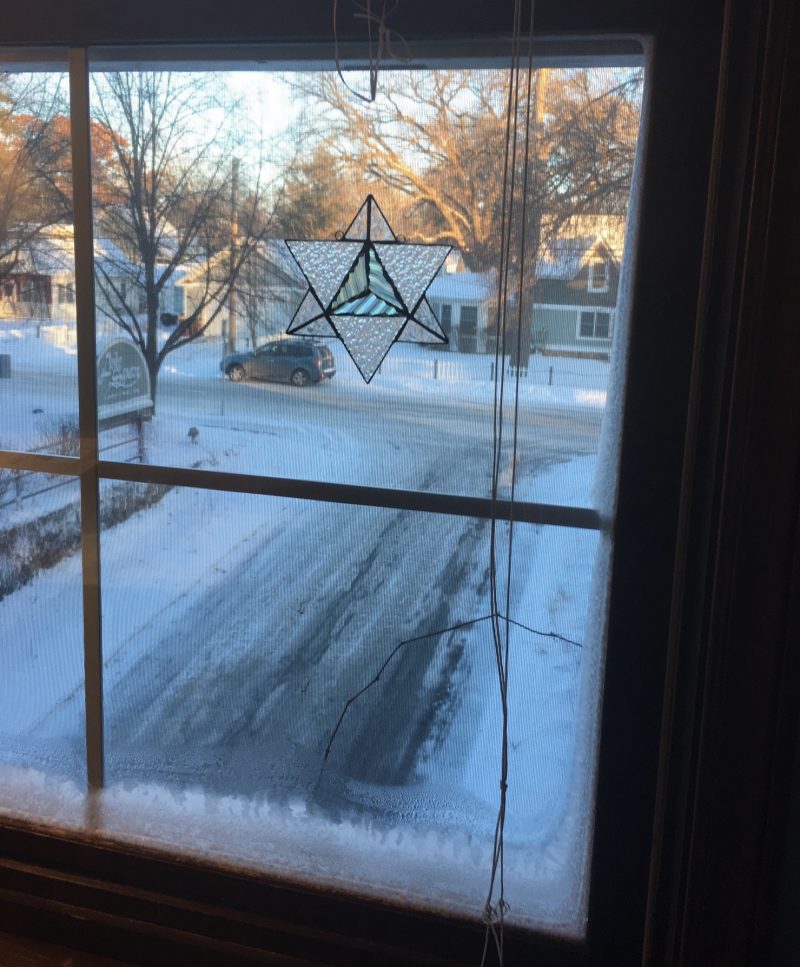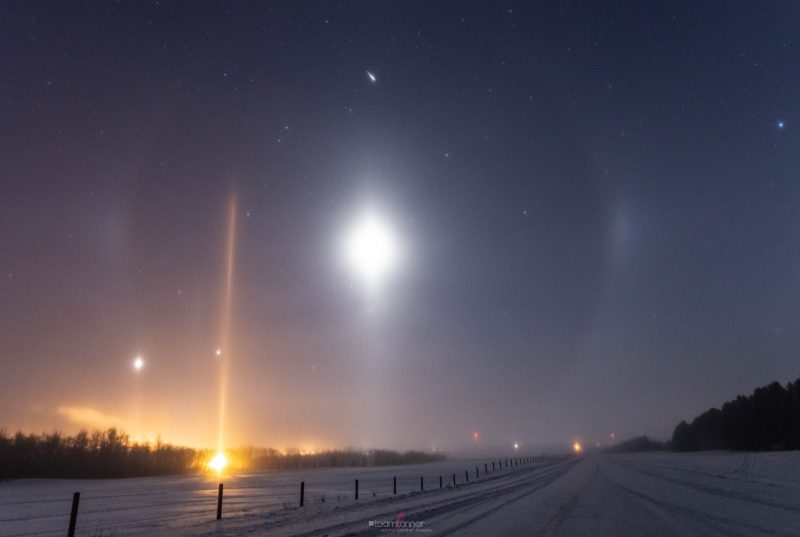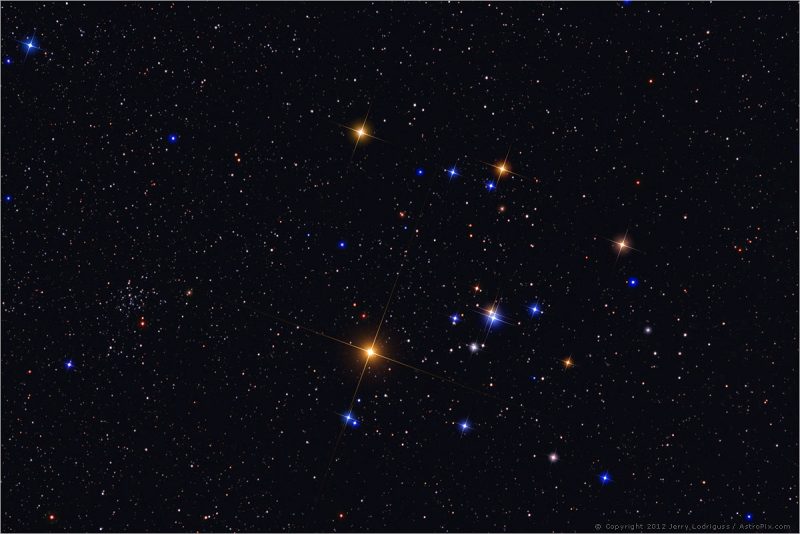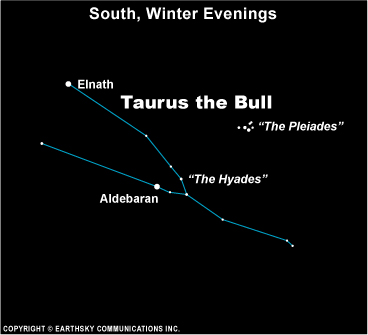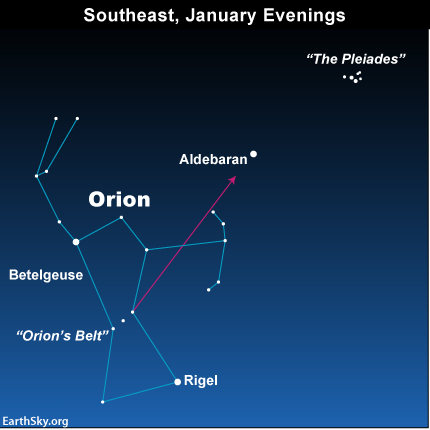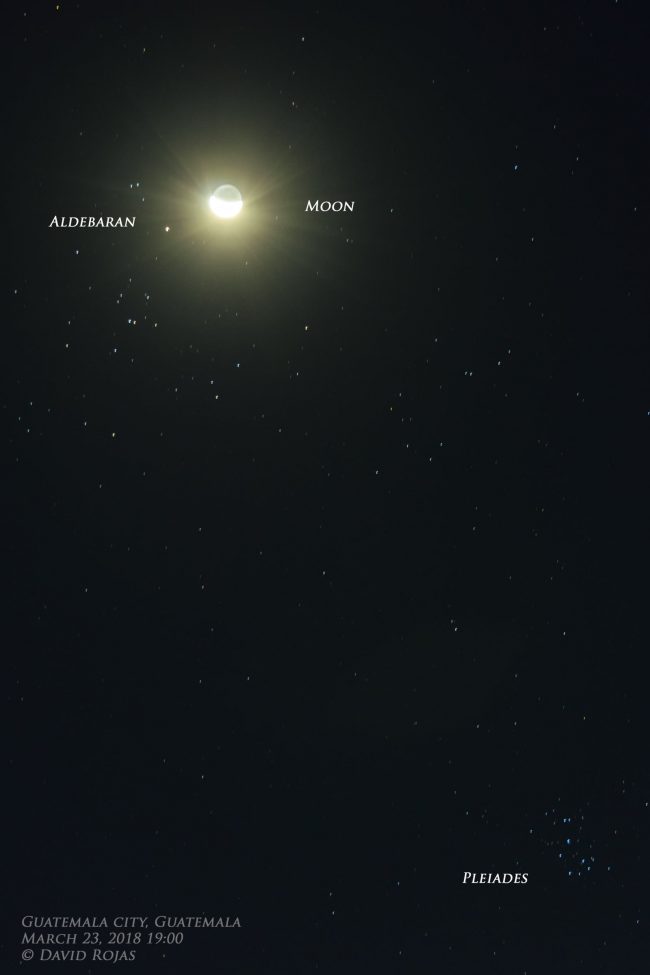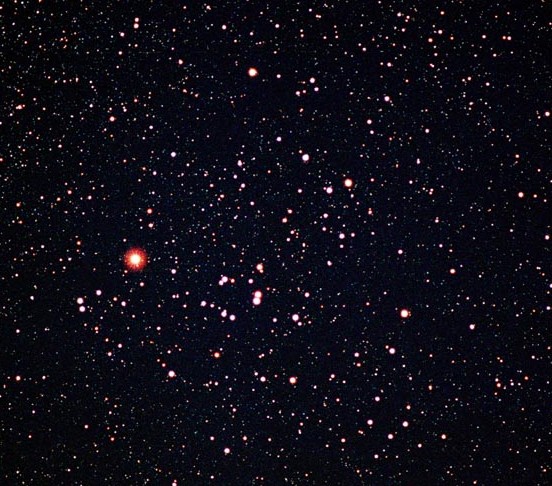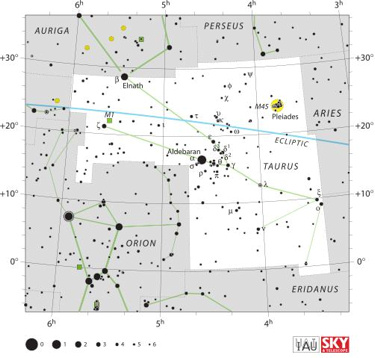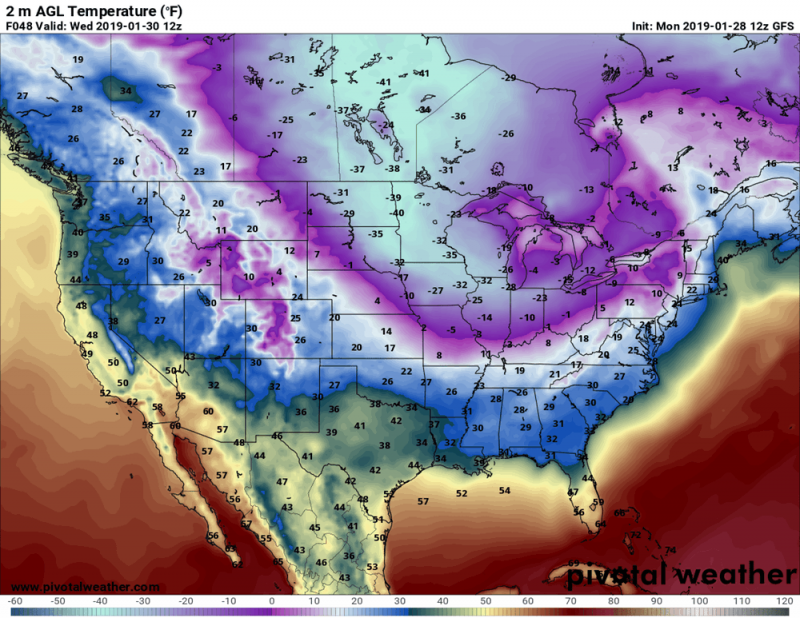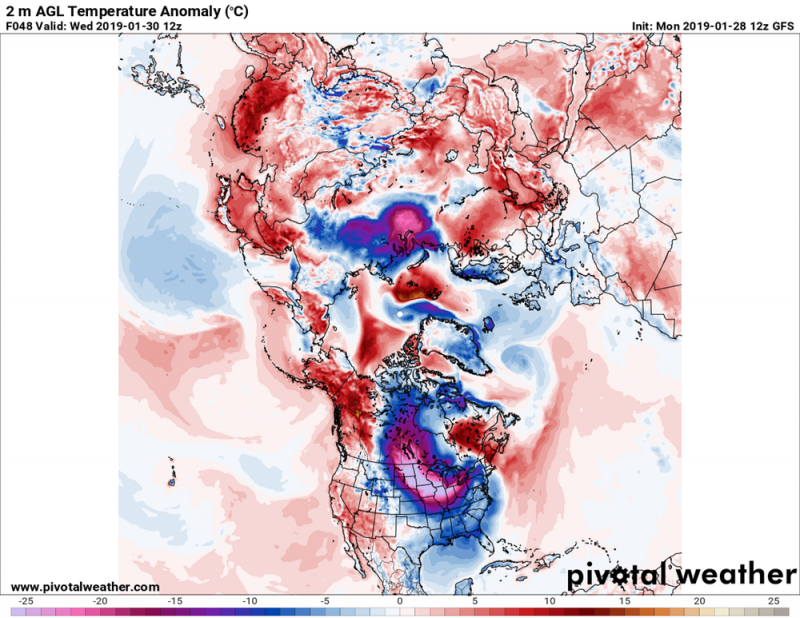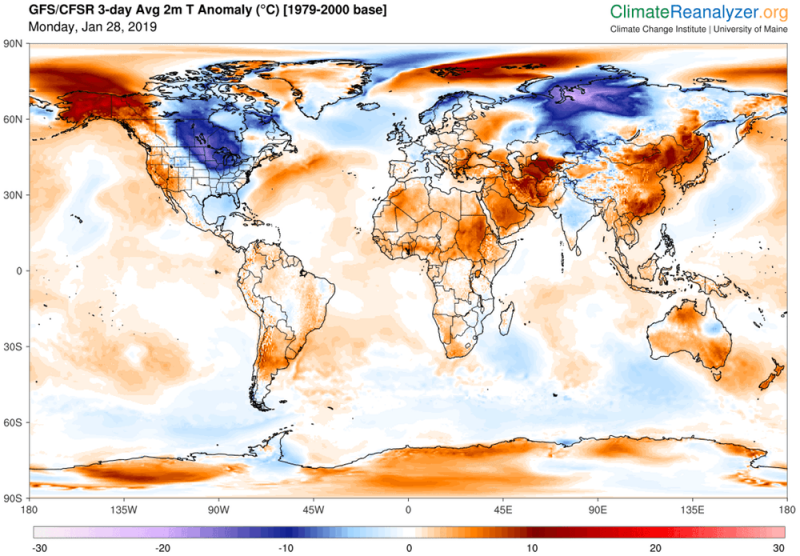
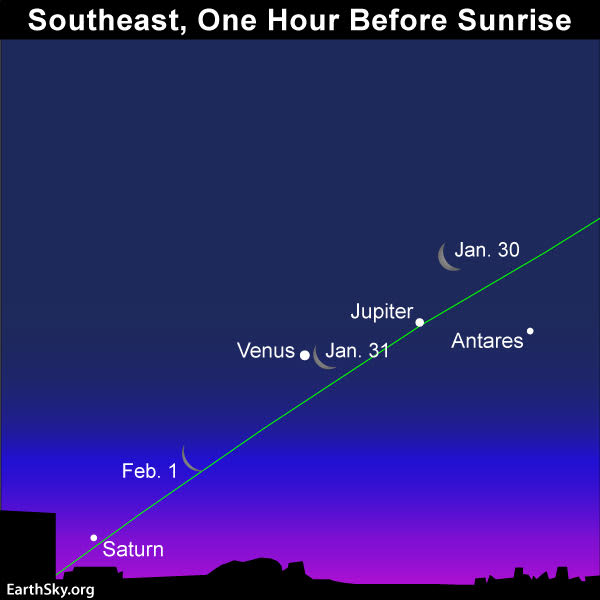
In late January and early February, watch the waning crescent moon slide past a string of morning planets: Jupiter, Venus and Saturn. Read more.
Click the name of a planet to learn more about its visibility in February 2019: Venus, Jupiter, Saturn, Mars and Mercury
Post your planet photos at EarthSky Community Photos
Venus is the brightest planet, beaming mightily in the east in the predawn/dawn sky all month long. Watch for the waning crescent moon to join up with Venus in the morning sky for a few days, centered on or near January 31. After that, the waning crescent moon will next pair up with Venus in early March.
This world reached a milestone in the morning sky on January 6, 2019, as this blazing world showcased its greatest elongation from the sun. In other words, on that date, Venus was a maximum angular distance of 46 degrees from the sun on our sky’s dome. Ever since, Venus has been slowly but surely sinking sunward.
The month starts out with Venus shining above Saturn in the morning sky, yet the month ends with Saturn shining above Venus. Day by day, Saturn climbs upward, away from the sunrise, while Venus sinks downward, toward the rising sun. The two will meet for a conjunction in the morning sky on February 18, 2019. All the while, Jupiter remains at the top of this line-up of three morning planets.
After this month, Venus will spend less time in the predawn sky before sunrise each morning, but it’ll still be dazzlingly bright and visible at dawn for months to come. At mid-northern latitudes, Venus will rise before astronomical twilight (dawn’s first light) until mid-March 2019; and at temperate latitudes in the Southern Hemisphere, Venus will rise before astronomical twilight until the end of May 2019.
Click here to find out when astronomical twilight comes to your sky, remembering to check the astronomical twilight box.
At mid-northern latitudes, Venus rises about three hours before sunrise in early January. By the month’s end, that’ll taper to about two hours.
At temperate latitudes in the Southern Hemisphere, Venus rises about 3 1/2 hours before sunup all month long.
At the month’s end and early March, watch for the waning crescent moon to promenade past Venus and the two other morning planets, Jupiter and Saturn. See a sky chart for the event below.
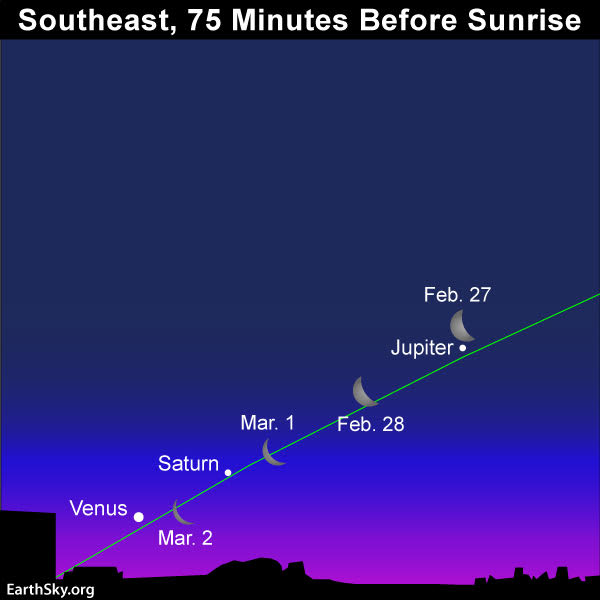
In late February and early March, watch the moon go by Jupiter, Saturn and Venus. Read more.
Jupiter is the second-brightest planet after Venus. The king planet reigns at the top of the morning line-up of planets all month long. At the beginning of February, Venus is found in between Jupiter and Saturn. On February 18, 2019, the planets Venus and Saturn are in conjunction beneath Jupiter. In the final week of February, the planet Saturn is found between Jupiter and Venus.
If you’re up during the predawn hours, you might notice a bright ruddy star in the vicinity of Jupiter on the sky’s dome. That’s Antares, the brightest star in the constellation Scorpius the Scorpion. Although Jupiter shines in the vicinity of Antares all year long, Jupiter can be seen to wander relative to this “fixed” star of the zodiac. Jupiter travels eastward, away from Antares, until April 10, 2019. Then, for a period of four months (April 10 to August 11, 2019), Jupiter actually moves in retrograde (or westward), closing the gap between itself and the star Antares. Midway through this retrograde, Jupiter will reach opposition on June 10, 2019, to shine at its brilliant best for the year.
Watch for the waning crescent moon to swing by Jupiter around January 30 and 31 and then again around February 27.
From mid-northern latitudes, Jupiter rises about 3 1/2 hours before the sun in early February. By the month’s end, that’ll increase to about four hours.
From temperate latitudes in the Southern Hemisphere, Jupiter comes up about four hours before sunrise at the beginning of the month. By the month’s end, Jupiter rises around the midnight hour.
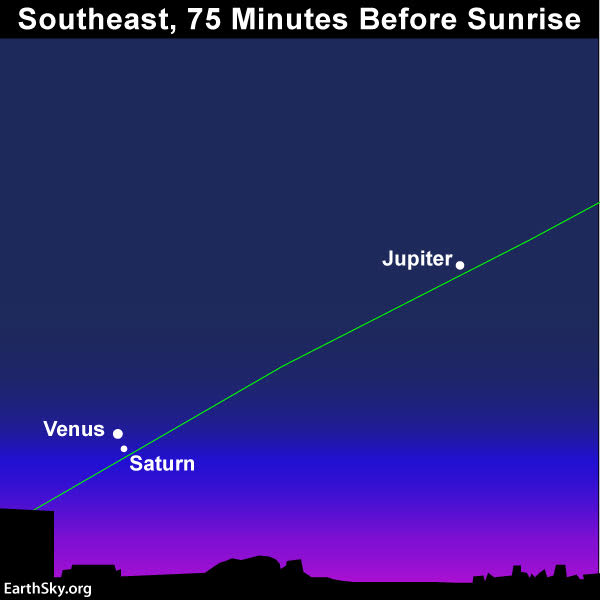
Watch for the conjunction of Venus and Saturn on February 18, 2019. Thereafter, Saturn will climb upward, away from the sunrise, while, Venus will descend in the direction of sunrise. Read more.
Saturn swung over to the morning sky, at least nominally, on January 2, 2019. But, for the most of January, this world sat too deeply in the glare of sunrise to be visible. Starting on or near January 30, avid sky watchers will use the waning crescent moon and the two brilliant planets, Venus and Jupiter, to guide them to Saturn’s place near the horizon as darkness begins to give way to dawn. This may present the first good opportunity for you to view Saturn in the morning sky in 2019.
Day by day throughout February, Saturn climbs upward, away from the sunrise. Venus, on the other hand, sinks sunward by the day. Saturn should be quite easy to see by the time that Venus and Saturn have their conjunction in the morning sky on February 18. Saturn, although as bright as a 1st-magnitude star, pales next to Venus. Venus ranks as the 3rd-brightest celestial object to light up the heavens, after the sun and moon, to outshine Saturn by some 80 times on their February 18th conjunction date.
From mid-northern latitudes, Saturn rises about 1 1/2 hours before the sun in early February. That’ll increase to about 2 1/2 hours before sunup by the month’s end.
From temperate latitudes in the Southern Hemisphere, Saturn rises about two hours before sunrise in early February, and by the month’s end, comes up about 3 1/2 hours before the sun.
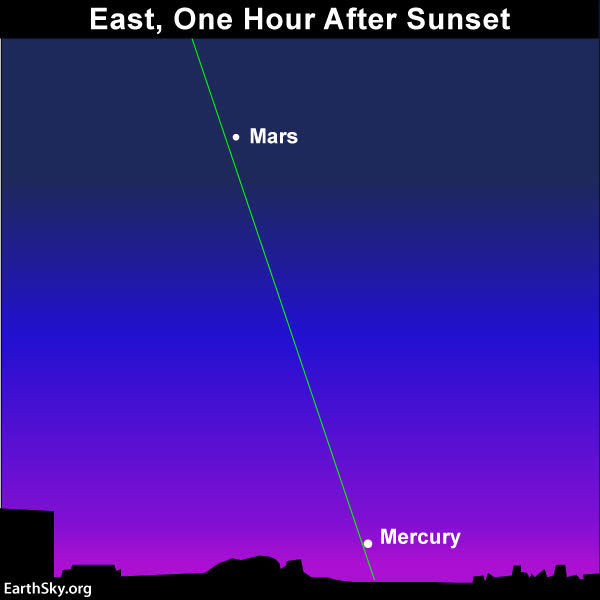
Starting in the second half of February 2019, try to find Mercury beneath Mars as evening twilight gives way to nightfall. Binoculars always come in handy for any Mercury quest. Read more.
Mercury, the innermost planet of the solar system, shifted over to the evening sky on January 30. But Mercury won’t be far enough from the setting sun to become visible in the evening sky until around mid-month (at northerly latitudes).
Mercury’s apparition in the evening sky will be especially favorable for the Northern Hemisphere in the last few weeks of February and early March 2019. But this will be an especially poor evening showing of Mercury at temperate latitudes in the Southern Hemisphere.
At mid-northern latitudes, Mercury sets about one hour after the sun by around mid-month, and by the month’s end, that’ll increase to about 1 1/2 hours.
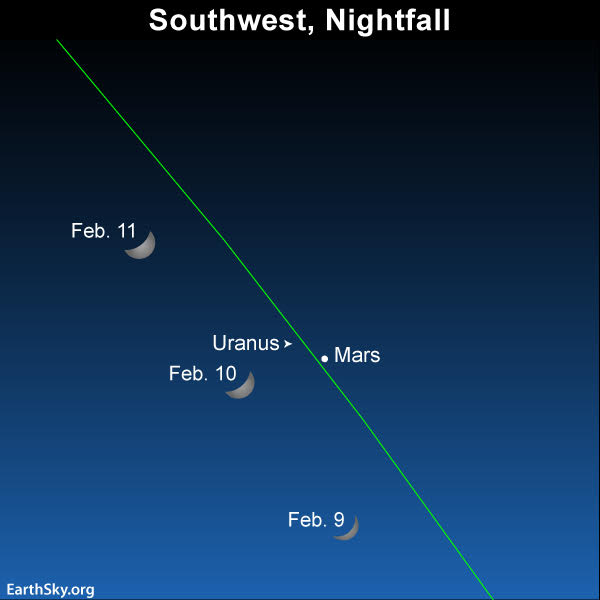
Look for the moon in the vicinity of Mars (and Uranus) for several evenings, centered on or near February 10. Read more.
Mars is the only bright planet to appear in the February evening sky all month long. At northerly latitudes, in the second half of the month, you may find Mercury beneath Mars, with Mercury lurking close to the horizon as evening dusk ebbs into darkness. Although Mars dims somewhat over the month, Mars remains modestly-bright, shining as brilliantly a 1st-magnitude star all month long. Moreover, Mars stays out till mid-evening at mid-northern latitudes, and until late evening in the Southern Hemisphere.
Click here for recommended sky almanacs providing you with the setting times for Mars.
Watch for the moon to shine in the vicinity of Mars for several evenings, centered on or near February 10. With binoculars you might even spot Uranus, the 7th planet outward from the sun, in the same binocular field with Mars each evening for about a week, centered on or near February 12. See the sky chart below.

On February 12, 2019, the lit side of the moon points right at Mars and Uranus. Despite the moonlit glare, binoculars may enable you to see the Mars/Uranus conjunction in a single binocular field. Read more.
What do we mean by bright planet? By bright planet, we mean any solar system planet that is easily visible without an optical aid and that has been watched by our ancestors since time immemorial. In their outward order from the sun, the five bright planets are Mercury, Venus, Mars, Jupiter and Saturn. These planets actually do appear bright in our sky. They are typically as bright as – or brighter than – the brightest stars. Plus, these relatively nearby worlds tend to shine with a steadier light than the distant, twinkling stars. You can spot them, and come to know them as faithful friends, if you try.
Bottom line: In February, Mars shines in the evening sky all month long, whereas Venus, Jupiter and Saturn adorn the morning sky. Mercury comes into view in the evening sky in the second half of the month. Click here for recommended almanacs; they can help you know when the planets rise and set in your sky.
Don’t miss anything. Subscribe to EarthSky News by email
Help EarthSky keep going! Donate now.
from EarthSky http://bit.ly/1YD00CF


In late January and early February, watch the waning crescent moon slide past a string of morning planets: Jupiter, Venus and Saturn. Read more.
Click the name of a planet to learn more about its visibility in February 2019: Venus, Jupiter, Saturn, Mars and Mercury
Post your planet photos at EarthSky Community Photos
Venus is the brightest planet, beaming mightily in the east in the predawn/dawn sky all month long. Watch for the waning crescent moon to join up with Venus in the morning sky for a few days, centered on or near January 31. After that, the waning crescent moon will next pair up with Venus in early March.
This world reached a milestone in the morning sky on January 6, 2019, as this blazing world showcased its greatest elongation from the sun. In other words, on that date, Venus was a maximum angular distance of 46 degrees from the sun on our sky’s dome. Ever since, Venus has been slowly but surely sinking sunward.
The month starts out with Venus shining above Saturn in the morning sky, yet the month ends with Saturn shining above Venus. Day by day, Saturn climbs upward, away from the sunrise, while Venus sinks downward, toward the rising sun. The two will meet for a conjunction in the morning sky on February 18, 2019. All the while, Jupiter remains at the top of this line-up of three morning planets.
After this month, Venus will spend less time in the predawn sky before sunrise each morning, but it’ll still be dazzlingly bright and visible at dawn for months to come. At mid-northern latitudes, Venus will rise before astronomical twilight (dawn’s first light) until mid-March 2019; and at temperate latitudes in the Southern Hemisphere, Venus will rise before astronomical twilight until the end of May 2019.
Click here to find out when astronomical twilight comes to your sky, remembering to check the astronomical twilight box.
At mid-northern latitudes, Venus rises about three hours before sunrise in early January. By the month’s end, that’ll taper to about two hours.
At temperate latitudes in the Southern Hemisphere, Venus rises about 3 1/2 hours before sunup all month long.
At the month’s end and early March, watch for the waning crescent moon to promenade past Venus and the two other morning planets, Jupiter and Saturn. See a sky chart for the event below.

In late February and early March, watch the moon go by Jupiter, Saturn and Venus. Read more.
Jupiter is the second-brightest planet after Venus. The king planet reigns at the top of the morning line-up of planets all month long. At the beginning of February, Venus is found in between Jupiter and Saturn. On February 18, 2019, the planets Venus and Saturn are in conjunction beneath Jupiter. In the final week of February, the planet Saturn is found between Jupiter and Venus.
If you’re up during the predawn hours, you might notice a bright ruddy star in the vicinity of Jupiter on the sky’s dome. That’s Antares, the brightest star in the constellation Scorpius the Scorpion. Although Jupiter shines in the vicinity of Antares all year long, Jupiter can be seen to wander relative to this “fixed” star of the zodiac. Jupiter travels eastward, away from Antares, until April 10, 2019. Then, for a period of four months (April 10 to August 11, 2019), Jupiter actually moves in retrograde (or westward), closing the gap between itself and the star Antares. Midway through this retrograde, Jupiter will reach opposition on June 10, 2019, to shine at its brilliant best for the year.
Watch for the waning crescent moon to swing by Jupiter around January 30 and 31 and then again around February 27.
From mid-northern latitudes, Jupiter rises about 3 1/2 hours before the sun in early February. By the month’s end, that’ll increase to about four hours.
From temperate latitudes in the Southern Hemisphere, Jupiter comes up about four hours before sunrise at the beginning of the month. By the month’s end, Jupiter rises around the midnight hour.

Watch for the conjunction of Venus and Saturn on February 18, 2019. Thereafter, Saturn will climb upward, away from the sunrise, while, Venus will descend in the direction of sunrise. Read more.
Saturn swung over to the morning sky, at least nominally, on January 2, 2019. But, for the most of January, this world sat too deeply in the glare of sunrise to be visible. Starting on or near January 30, avid sky watchers will use the waning crescent moon and the two brilliant planets, Venus and Jupiter, to guide them to Saturn’s place near the horizon as darkness begins to give way to dawn. This may present the first good opportunity for you to view Saturn in the morning sky in 2019.
Day by day throughout February, Saturn climbs upward, away from the sunrise. Venus, on the other hand, sinks sunward by the day. Saturn should be quite easy to see by the time that Venus and Saturn have their conjunction in the morning sky on February 18. Saturn, although as bright as a 1st-magnitude star, pales next to Venus. Venus ranks as the 3rd-brightest celestial object to light up the heavens, after the sun and moon, to outshine Saturn by some 80 times on their February 18th conjunction date.
From mid-northern latitudes, Saturn rises about 1 1/2 hours before the sun in early February. That’ll increase to about 2 1/2 hours before sunup by the month’s end.
From temperate latitudes in the Southern Hemisphere, Saturn rises about two hours before sunrise in early February, and by the month’s end, comes up about 3 1/2 hours before the sun.

Starting in the second half of February 2019, try to find Mercury beneath Mars as evening twilight gives way to nightfall. Binoculars always come in handy for any Mercury quest. Read more.
Mercury, the innermost planet of the solar system, shifted over to the evening sky on January 30. But Mercury won’t be far enough from the setting sun to become visible in the evening sky until around mid-month (at northerly latitudes).
Mercury’s apparition in the evening sky will be especially favorable for the Northern Hemisphere in the last few weeks of February and early March 2019. But this will be an especially poor evening showing of Mercury at temperate latitudes in the Southern Hemisphere.
At mid-northern latitudes, Mercury sets about one hour after the sun by around mid-month, and by the month’s end, that’ll increase to about 1 1/2 hours.

Look for the moon in the vicinity of Mars (and Uranus) for several evenings, centered on or near February 10. Read more.
Mars is the only bright planet to appear in the February evening sky all month long. At northerly latitudes, in the second half of the month, you may find Mercury beneath Mars, with Mercury lurking close to the horizon as evening dusk ebbs into darkness. Although Mars dims somewhat over the month, Mars remains modestly-bright, shining as brilliantly a 1st-magnitude star all month long. Moreover, Mars stays out till mid-evening at mid-northern latitudes, and until late evening in the Southern Hemisphere.
Click here for recommended sky almanacs providing you with the setting times for Mars.
Watch for the moon to shine in the vicinity of Mars for several evenings, centered on or near February 10. With binoculars you might even spot Uranus, the 7th planet outward from the sun, in the same binocular field with Mars each evening for about a week, centered on or near February 12. See the sky chart below.

On February 12, 2019, the lit side of the moon points right at Mars and Uranus. Despite the moonlit glare, binoculars may enable you to see the Mars/Uranus conjunction in a single binocular field. Read more.
What do we mean by bright planet? By bright planet, we mean any solar system planet that is easily visible without an optical aid and that has been watched by our ancestors since time immemorial. In their outward order from the sun, the five bright planets are Mercury, Venus, Mars, Jupiter and Saturn. These planets actually do appear bright in our sky. They are typically as bright as – or brighter than – the brightest stars. Plus, these relatively nearby worlds tend to shine with a steadier light than the distant, twinkling stars. You can spot them, and come to know them as faithful friends, if you try.
Bottom line: In February, Mars shines in the evening sky all month long, whereas Venus, Jupiter and Saturn adorn the morning sky. Mercury comes into view in the evening sky in the second half of the month. Click here for recommended almanacs; they can help you know when the planets rise and set in your sky.
Don’t miss anything. Subscribe to EarthSky News by email
Help EarthSky keep going! Donate now.
from EarthSky http://bit.ly/1YD00CF



